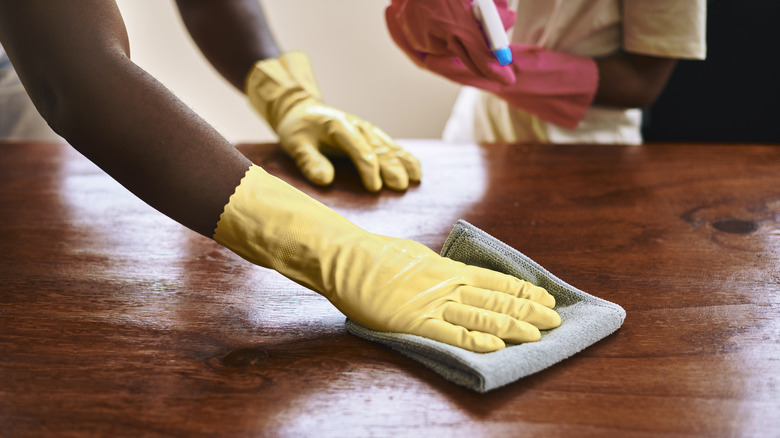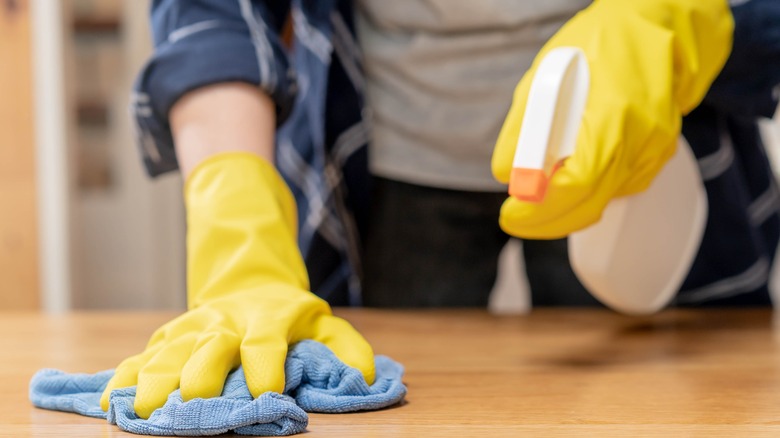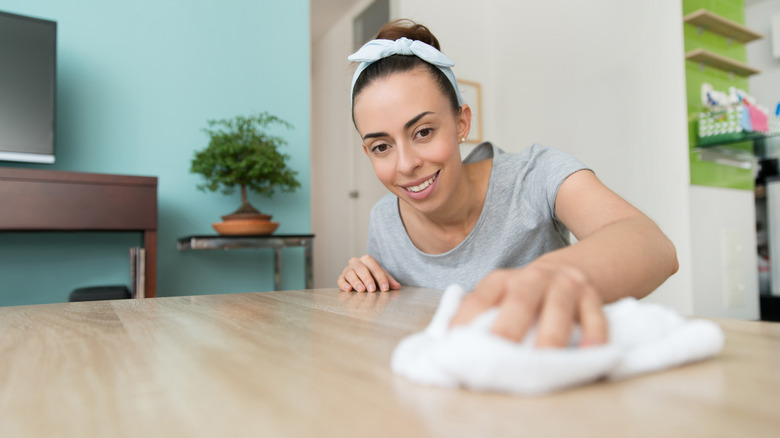Using This Common Cleaning Product On Wood Furniture Is A Big Mistake
In the 2002 hit "My Big Fat Greek Wedding," Toula Portokalos's father said, "Put some Windex on it!" and proceeded to cure everything from a mosquito bite to a skin rash with this renowned cleaning product. After all, its effervescent sapphire solution does wonders for dirty mirrors and scummy windows, removing any scuffs or impurities with a paper towel and the flick of a wrist. According to Windex, the original glass cleaner "starts working on dirt, grime, fingerprints and other messes even before you wipe." It's not a stretch to imagine that the average consumer may wrongly assume that Windex can be used on any surface that needs a quick and easy clean. One surface that should be avoided with Windex, however, is natural wood furniture, which is often coated with varnishes, lacquers, or other protective finishes to enhance its durability.
Many Windex products contain ingredients that can be harmful to wood furniture, such as ammonia and alcohol. Ammonia is a strong alkaline substance that can strip away the protective finish of wood and cause it to dry out, leading to cracks and discoloration. Though some Windex products are ammonia free, they still are intended for glass, not wood. Additionally, alcohol can act as a solvent, breaking down the finish and exposing the wood to further damage. The good news is there are other simple ways to clean wood that won't damage your furniture.
How to safely clean your wood furniture with diluted vinegar
As an alternative to Windex, grab a bottle of white vinegar from your pantry instead. Diluted white vinegar is a versatile cleaning tool that's safe to use on wooden furniture primarily due to its natural properties. Unlike harsh chemical cleaners that may contain abrasives or solvents that can damage wood finishes, white vinegar is a gentle and non-toxic option. Its acidity is at a level that is effective in breaking down grease and grime without causing harm to the wood or its protective coating.
To safely use white vinegar on wooden furniture, create a simple diluted cleaning solution by mixing 3 tablespoons of distilled vinegar with 1 cup of water. Pour the mixture into a spray bottle for easy application. Before applying the solution to the entire surface, it's advisable to test it on a small, inconspicuous area to ensure compatibility with the wood and its finish. Once confirmed, spray the solution onto a soft, lint-free cloth or sponge. Gently wipe down the furniture, paying attention to areas with visible dirt or stains. Ensure that the cloth or sponge is only damp, not soaking wet, to prevent excessive moisture on the wood. After cleaning, wipe the furniture with a clean, dry cloth to remove any remaining vinegar solution and moisture, leaving the wooden surface clean and refreshed.
Using soap and water to clean your wood furniture
While a diluted vinegar solution works well on wood furniture, mild soap and water are also safe to use. Mild soap is typically free from damaging elements that could harm the wood or its finish and will help to break down dirty surfaces without compromising the integrity of the wood.
To clean wooden furniture with mild soap and water, create a cleaning solution by adding a small amount of mild liquid soap, such as dish soap or Castile soap, to warm water. Mix the solution until it forms suds. Dampen a soft cloth or sponge in the soapy water, ensuring it is not excessively wet as too much moisture can damage porous wooden surfaces. Gently wipe down the wooden furniture, paying attention to areas with visible dirt or stains. After cleaning, use a clean, dry cloth to wipe away excess moisture and soap residue. Always perform a small patch test in an inconspicuous area to ensure compatibility with the wood and its finish. This can be done with a microfiber cloth or even a cotton ball to protect the wood surface from scratches.


